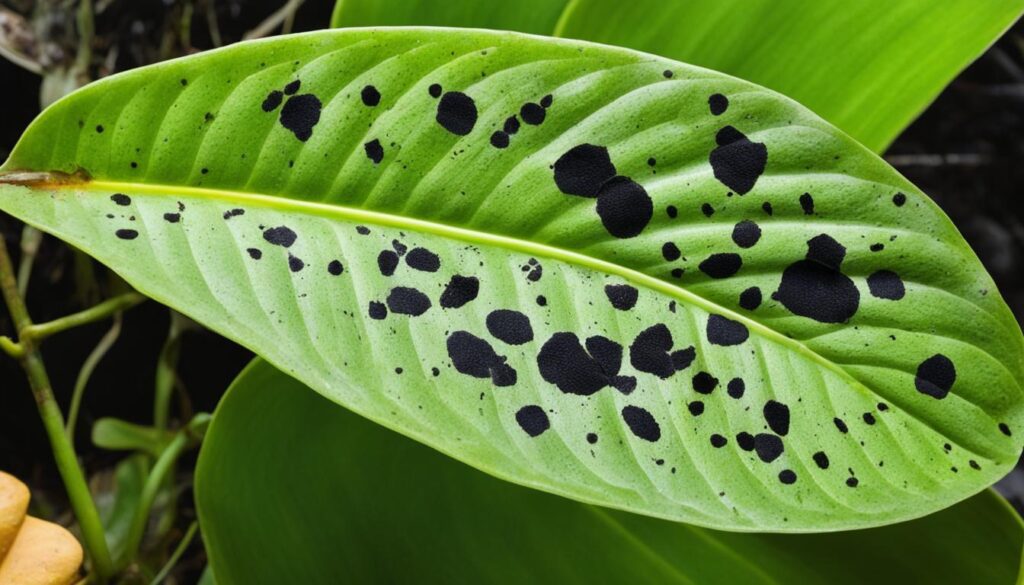If you’re an orchid enthusiast, you know how beautiful and delicate these plants can be. However, the appearance of black spots on orchid leaves can be a cause for concern. These black spots are often a sign of black rot, a fungal infection that can quickly spread and destroy your beloved orchid if left untreated.
Black rot is caused by fungi such as Pythium ultimum and Phytophthora cactorum. These fungi thrive in moist environments, and they can enter your orchid leaves through spores. Once inside, they quickly spread, causing small, watery, translucent spots that expand and eventually turn brown, then black.
Prevention is key when it comes to black spots on orchid leaves. By taking preventive measures such as using sterilized pots and media, avoiding prolonged leaf wetness, and ensuring good air circulation, you can significantly reduce the risk of fungal infections.
However, if you do notice black spots on your orchid leaves, it’s essential to take immediate action. Mechanical treatment involves cutting out the infected portion of the plant. Afterward, applying a fungicide like cinnamon or a Bordeaux mixture can help protect the remaining healthy tissue.
With proper care and attention, you can prevent the occurrence and spread of black rot, keeping your orchids healthy and free from unsightly black spots. In the following sections, we will explore the causes of black spots on orchid leaves in more detail, as well as the treatment and prevention methods you can implement to ensure the long-term health of your orchids.
Causes of Black Spots on Orchid Leaves
The occurrence of black spots on orchid leaves is primarily caused by the presence of fungi, specifically Pythium ultimum and Phytophthora cactorum. These fungi rely on water to survive and spread. They produce spores, also known as zoospores, that can penetrate the plant tissue when they come into contact with water sitting on the orchid leaves. Once inside the plant, the fungi develop a mycelium consisting of hyphae, which quickly spread through the affected tissues. This results in the formation of small, watery, translucent spots that eventually turn brown and then black.
The fungi can infect various parts of the orchid, including leaves, pseudobulbs, and roots. Certain orchid varieties, such as Cattleyas, are particularly susceptible to black rot.
Treatment and Prevention of Black Spots on Orchid Leaves
When it comes to dealing with black spots on orchid leaves, a combination of mechanical and chemical methods can be effective. Here’s what you can do to treat and prevent the spread of black spots:
- Mechanical treatment: Begin by using a sterile knife to carefully remove the infected portion of the plant. It is important to cut into healthy tissue to prevent further spread of the fungus. After removing the infected area, allow the cut to dry in an area with good air circulation. This step ensures that the remaining healthy tissue is protected.
- Chemical treatment: Fungicides play a crucial role in safeguarding the remaining healthy tissue from fungal infection. One effective option is cinnamon, which can be applied directly to the affected area. Another method is to mix cinnamon with glue or cooking oil to form a paste, which can then be applied. Additionally, there are various fungicides available such as Truban, Terrazole, Aliette, Subdue, Captan, Dithane M-45, and Physan 20. The selection of fungicide depends on the severity of the infection.
While treating black spots is important, prevention is equally essential to maintain healthy orchid plants. Here are some preventive measures you can take:
- Sterilizing pots and media: Before planting your orchids, ensure that the pots and media are properly sterilized. This helps eliminate any existing fungal spores and reduces the risk of infection.
- Avoiding prolonged leaf wetness: Fungi thrive in moist environments, so it is important to avoid keeping the leaves excessively wet. Ensure proper drainage and watering practices to prevent the growth and spread of fungi.
- Maintaining good air circulation: Fungi tend to thrive in still, stagnant air. Creating a well-ventilated environment for your orchids helps prevent the buildup of humidity and reduces the risk of fungal infections.
- Elevating orchids off the ground: If you keep your orchids outdoors, consider elevating them off the ground. This reduces the chances of soil-borne pathogens coming into contact with the leaves.
- Using high-calcium fertilizer: In the spring, use a high-calcium fertilizer to promote healthy new growth. This strengthens the plants and enhances their ability to resist fungal infections.
By following these treatment and prevention strategies, you can effectively manage black spots on orchid leaves and maintain thriving, disease-free orchid plants.
Conclusion
Black spots on orchid leaves are a common indicator of black rot, a fungal infection that can rapidly spread and devastate entire orchid plants. To effectively manage this issue, it is essential to take prompt treatment and prevention measures.
Mechanical treatment involves cutting out the infected areas of the plant and applying suitable fungicides such as cinnamon or a Bordeaux mixture. This helps protect the remaining healthy tissue from further damage and inhibit the spread of the fungus.
Prevention is key to avoiding black spots on orchid leaves. By sterilizing pots and media, avoiding prolonged leaf wetness, and ensuring good air circulation, orchid enthusiasts can significantly reduce the risk of black rot. Raising orchids off the ground when outdoors and incorporating high-calcium fertilizer in the spring can also aid in preventing black rot in new growth.
With proper care and attention, you can enjoy the beauty of your orchid plants without the worry of unsightly black spots on the leaves. By implementing these treatment and prevention strategies, your orchids can thrive and remain healthy, bringing you joy for years to come.
Are the Causes of Black Spots on Raspberries Similar to Those on Orchid Leaves?
Black spots on raspberries causes and those on orchid leaves may differ. Raspberries are susceptible to fungal diseases like anthracnose and botrytis, leading to dark spots. Orchid leaves, on the other hand, may experience black spots due to various factors such as overwatering, pests, or sunburn. While some causes may overlap, it’s essential to address the specific issues affecting each plant to ensure their health and vitality.










